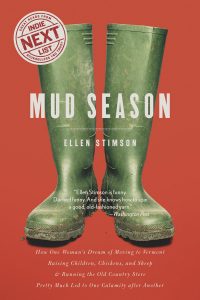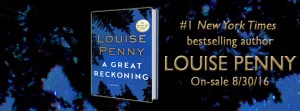Ruth Reichl
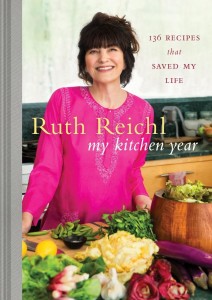 My Kitchen Year ~ 136 Recipes that Saved My Life by Ruth Reichl
My Kitchen Year ~ 136 Recipes that Saved My Life by Ruth Reichl
I’d been lusting after this book since it first came out. I was hoping it would come into the the bookstore where I work (and have a discount), but it never did. My friend and fellow foodie, Susan, already had the book and was full of yummy descriptions. I told her I had to have it and was just going to buy it – expense be damned. Then, a few days later, Susan announced she had come into an “extra” copy which she would give me. (I secretly suspect my dear friend actually bought it for me, but we’ll go with her story.)
From the book’s publicity blurb:
In the fall of 2009, the food world was rocked when Gourmet magazine was abruptly shuttered by its parent company. No one was more stunned by this unexpected turn of events than its beloved editor in chief, Ruth Reichl, who suddenly faced an uncertain professional future. As she struggled to process what had seemed unthinkable, Reichl turned to the one place that had always provided sanctuary. “I did what I always do when I’m confused, lonely, or frightened,” she writes. “I disappeared into the kitchen.”
Happily this is more than just a cookbook, although it is packed with (as the title states) 136 hunger-inducing recipes — what makes My Kitchen Year shine is Ms. Reichl’s personal writings, snippets from her journal, and musings on food interspersed between the recipes. She tells of the final weeks closing up the magazine, packing her office. Of going into Chinatown with her beloved fellow staffers for a final lunch at a favorite restaurant. And how can you not have a craving for chocolate cake when reading this passage?:
I needed an antidote to the poison of self-pity. What I needed, I decided, was to bake a chocolate cake. I emailed a few friends, asking them to tea. Why a cake? Because the precision of baking demands total attention. Why this cake (The Cake that Cures Everything)? Because the sheer size of it makes special demands. But most of all, because it is impossible to hold on to gloom with so much chocolate wafting its exuberant scent into every corner of the house.
Most everyone was saddened when Gourmet magazine suddenly stopped publication (I was a subscriber for over 15 years and am still in mourning) but, apparently, none of us were as astonished as Ms. Reichl, herself. She knew nothing of the decision and had, in fact, personally supervised the December issue which, sadly would never make it to press. How I would have liked to see that last issue. She ruefully describes how each magazine issue would have had multiple covers of beautifully photographed Christmas cookies.
Reeling, she escapes to her home in upstate NY …
I longed for the feel of knife in my hand, the heft of water splashing into a pot. Yearned for the joyous sizzle, burble, and hiss that are the ever-changing soundtrack of the kitchen. I missed the daily transformations: fruit ripening, dough rising, bread toasting into golden slabs. I’d always thought of these elemental pleasures as minor diversions, but now I understood they they’re the glue that holds my life together….in a world filled with no, it is my yes.
This long-time food writer and one time NY Times restaurant critic has made a career of haute cuisine. But here Ms. Reichl shares her appreciation (and recipes) for simple meals, often made with farmer market obtained fresh ingredients. She has eaten the world’s best food in the finest restaurants, yet upon bringing home spring’s first asparagus, she cooks it quickly, drizzles it with fine olive oil and eats the spears by hand while still standing at the stove.
Ms. Reichl uses food as a gift of love, not only for herself, but also for her friends and family. Whereas before, she would have gone to someplace fancy with lowered voices and expensive menus, now she entertains at home, serving her home-made meals around her table where everyone happily lingers, talking until the wee hours. She looks around and feels at peace and finally, at home.
In terms of a cookbook, the recipes are wonderful. Not overwritten with just the right amount of instruction. There are plenty of Asian inspired entries, but nothing too complicated. I just counted and I have pencil checked at least 25 in the index to try – Fresh Apricot Pie and Food Cart Curry Chicken are in the plans for the near future here in the Book Barmy kitchen.
I have read all of Ms. Reichl’s books (list HERE) and they range from her early childhood with a mother who was a horrible cook to one of my favorites Garlic and Sapphires which recounts her days as a restaurant critic (which often required donning various disguises). During the year after Gourmet, she also wrote a novel called Delicious – a fun plot which mimics her own experience — namely, the closing of a food magazine and the poor writer who stayed behind to answer all the on-going readers letters.
You don’t have to be a hard-core foodie, or a past subscriber to Gourmet Magazine to enjoy any of Ms. Reichl’s books. But, if you appreciate good cooking and delicious meals, do go ahead and treat yourself to your own copy of My Kitchen Year.
(Thank you Susan)
Mud Season by Ellen Stimson
New England is a beautiful but often harsh place to live. Husband and I met and married there, but when grad school and a job offer whisked us off to gentler climes, we never looked back.
My sister and her husband are made of sturdier stuff. They live in the New Hampshire woods by a creek. As native New Englanders, they flourish through all the seasons; the crisp autumn days, the long snow-bound winters, the clouds of black flies in the spring, the hot sticky summers, and even the muddy inbetween season. During the long winters, they often loose power (which means no pump, so no running water), so they bring in buckets of water from the creek for flushing and to heat on their wood stove for washing. They don extra layers of clothing, bring in firewood, light candles and wear headlamps –calmly making do until power is restored — in other words — They Forge On.
Forging on is just what Ms. Stimson does in Mud Season — (aptly subtitled How One Woman’s Dream of Moving to Vermont, Raising Children, Chickens and Sheep, and Running the Old Country Store Pretty Much Led to One Calamity After Another).
This memoir, which the author admits is only 78% true, tells the story of a St. Louis family who move to Vermont, after falling in love with it on a vacation. Ah yes, you may be thinking, another one of those How-to-move-to-the-country-and-have-an-idyllic-life stories.
Well, not really — actually, not at all.
Ms. Stimson is snarky, sarcastic, and very, very funny. With her family in tow, she doesn’t so much as move into the small town of Dorset, she invades it … and colossal failures ensue.
They spend an outrageous amount of money renovating their old farmhouse using out of state contractors. They go on to purchase chickens and goats – knowing nothing about their care. Their son is acting out in the local school and after a run in with the administration, they take on home schooling which doesn’t go well. (A science lesson results in a red-dyed pond and a subsequent police investigation.)
Ms. Stimson decides to open what she calls a “quaint country store” and caters to the tourist’s Disney version of Vermont – even charging $4 each for peaches from New York (gasp!). When the tourists leave, so do their store sales.
You’ll simultaneously laugh and cringe at Ms. Stimson’s cavalier attitude and misguided good intentions. This is no gentle, “let’s take things slowly and get to know the locals” approach — this is forging on with misguided plans of making a living in the Republic of Vermont with profoundly ill-advised decisions.
The book is smattered with wisecracking footnotes which reflect the author’s wry self-depreciation – her afterthoughts on how she could have done things differently, but she just can’t seem to learn. Her irresponsible optimism blinds her judgement and she just keeps forging ahead.
When Ms. Stimson does try to fit in, it results in yet more mishaps. She dresses up with scarf and heels for local festival and later reflects on the standard Vermont uniform…
…khakis and sensible shoes with a blue chambray linen blouse and some version of fleece on top. No lipstick. LLBean. Steady and reliable.
She gamely agrees to open her house for the spring home tour, forgets the date and is found out back mucking out the chicken shed — with a very messy house.
So I did the only real thing that I ever could do. I walked up the hill, took off my poopy gloves, offered my cold, chapped hand, and said “Hello, won’t you please come in?”
A beautiful waterfall only a 10 minute walk from her house brings her quiet joy and she lovingly describes the smell of each season. And so you begin to believe she’s going to make it — one can only hope she’ll start to get it. Then, during the often freezing mud season, the unpredictable, bighearted Ms. Stimson adopts two orphaned lambs and keeping them warm indoors, seems surprised when they destroy their beautiful renovated house. It seems they won’t be house trained.
Mud Season is an outlandish, funny read until the last few chapters, when the family’s dreams and reality collide into bankruptcy, the closing of the (now called) “horrible” quaint country store, and having to take jobs out of state with long commutes.
Mud Season may have been written more for humor than accuracy but if even half of it is true, here’s a cautionary tale. A tale of how not to barge into a small Vermont town, how not to become friends with the locals, how not to to be part-time farmer, home schooler or a quaint country store proprietor. But it’s a journey that will have you laughing the whole way.
Ms. Stimson has written a follow up book called Good Grief – Life in a Tiny Vermont Village – not sure I can take any more of her foolish antics, no matter how funny.
Passport Photo
 It was time to renew my passport. Husband and I travel a great deal, so I always keep my passport up to date, but also because I have a secret fantasy
It was time to renew my passport. Husband and I travel a great deal, so I always keep my passport up to date, but also because I have a secret fantasy
I had a wonderful university professor who taught International Politics & Relations — an elegant older English woman who spoke six languages, had degrees from both Oxford and Cambridge (thank you very much), and dressed like Diana Vreeland. We met for a conference one morning and over a cup of tea, she told the story of falling hard for a Frenchman visiting London. He wanted to take her to his chateau on the Cote d’Azure, but because her passport was expired and it would take 3-4 weeks to renew it, he had to leave and she never heard from him again.
Now this was probably a good thing, she reminisced, because he was a cad not to keep in touch and extend the invitation again once she did have a valid passport…but it taught her a valuable lesson about never letting your passport expire. And her words still echo in my mind — keep your passport up-to-date at all times, you never know when a fabulous Frenchman will want to wisk you off to his castle on the Riviera.
It was time to renew my passport and I’ve always – always hated my previous passport photos taken by some gum-chewing drugstore employee under harsh florescent lights. Erma Bombeck said “When you look like your passport photo, it’s time to go home.” Given my past photos, I never should have been let outside of my own country. I always feared I looked like a escaped convict on an international no-fly list.
Luckily, I discovered that the passport website has instructions for taking your own passport photo, and a tool to load your image to check that it will meet the sizing requirements – check it out HERE.
Donning a black turtle neck, I spent an inordinate amount of time on my unruly hair, put on some makeup, and found a blank wall for the background. Husband then valiantly suffered through the taking of dozens of photos; “no try again, my hair looks funny”, “yuck look at my double chin”, “too close — my head is huge!”, “err, nice, but let’s try another”…until we had a winner.
My passport arrived in the mail the other day and I opened it warily preparing for the worst — but I actually don’t hate it.

Now, just waiting for that Frenchman…
All the Light We Cannot See by Anthony Doerr
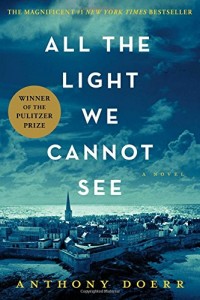 Last night, I closed All the Light I Cannot See and asked myself, what the heck happened to this beautiful novel? (OK I didn’t say heck, just trying to keep it clean here at Book Barmy.)
Last night, I closed All the Light I Cannot See and asked myself, what the heck happened to this beautiful novel? (OK I didn’t say heck, just trying to keep it clean here at Book Barmy.)
This WWII blockbuster opens with two riveting story lines. Werner, an orphan German teen is recruited by the Nazi’s for his invaluable radio engineering skills, and Marie-Laure, a blind French girl – separated from her adoring father in war-torn France. Right from the beginning, the reader knows that the lives of these two potentially fascinating characters will intersect.
The novel also has some captivating scenes, all beautifully written. There’s Marie-Laure reading aloud from her braille edition of 20,000 Leagues Under the Sea, there’s the ominous agenda inside Werner’s exclusive Nazi training school, and then, if you’re like me, you’ll hold your breath as messages are passed along, hidden in freshly baked bread, and then secretly broadcast from a short-wave radio hidden in the attic of a crumbling house perched on the edge of the sea. Everything is there — all the elements of a well-written and exciting WWII adventure.
And so you settle in, cup of tea in hand and eagerly start reading…and reading…and reading — through 178 chapters. Yes, you read that right — 178 chapters!
Therein lies the first problem — 178 short chapters, many only a few pages, which jerk the reader back in forth in time, often with no clue to the year. The choppy chapters and abrupt time jumps are not only confusing, they actually prevented me from really sinking into the story. One reviewer, knowing that Mr. Doerr is a much better writer than this, surmised his editors insisted on shuffling the timeline. The format did feel gimmicky and like an afterthought. I’d go even further, I think those same editors also insisted on chopping the novel into short chapters to cater to today’s 140-character-tweet-text-snapchat-attention-span readers (That just wrote itself in the throes of my rant – like it?).
Now we come to the second problem, All the Light We Cannot See starts out beautifully written and compelling, but then it just seems to fall apart — rather it just never comes together. Werner’s and Marie-Laure’s paths, while coming teasingly close, never really converge. And when they do finally intertwine, they are only together for 10 pages towards the end. Then fast forward 30 years and the book ends not with a bang but with a whimper (my apologies to T. S. Eliot).
The novel won Pulitzer Prize, earned many glowing reviews and many weeks on the bestseller lists. Perhaps I missed something magical in my reading of this book. Maybe it was my mood. Whatever the reason, I was underwhelmed and sadly disappointed upon finishing this novel.
A digital review copy was provided by Scribner via NetGalley.
Louise Penny is back
I just received an advanced readers copy of this – so excited.
Thanks to Netgalley and the St. Martin’s Press.
I know you’re all extremely jealous, but in the meantime, please enjoy Ms. Penny being interviewed by her long-time friend at the CBC.
I have two other books going, but I may have to throw them aside for this… stay tuned …
Dinner with Edward by Isabel Vincent
 Mini-Review
Mini-Review
Okay, I thought, another Tuesday’s with Morrie-type book, but I opened it anyway the other night – needing a little break from my current WWII read. And yes, Dinner with Edward is very much in the same genre. The age-old story of a friendship between a young troubled character and an much wiser, older person.
Only this time, the older Edward is a gourmet cook and prepares delicious dinners for the younger, having-trouble-with-her-marriage Isabel. Edward has just lost his wife and Isabel’s friend (who lives out of state) asks her to check in on him by letting him prepare her dinner a few nights a week. Together, they plot, this will keep Edward happy and busy, while giving Isabel a much-needed break from her failing marriage.
Each chapter starts with a menu of the glorious meal he prepares for Isabel and the drinks enjoyed before dinner — old fashioneds, martinis – grown up drinks. It is over these drinks and delicious food that the conversations, reminisces, and problems unfold.
I had trouble finishing this book, and found it dull and predictable — same old problems — same old trite wisdom’s from an elderly man. Slow down, enjoy life as if every day is your last, and even this quote from the book:
He knew that paradise was not a place, but the people in your life. (groan)
I never felt that “paradise” connection between Isabel and Edward, as each chapter reads like a disconnected short story. Edwards memories and past experiences never really connect with Isabel’s current day problems. Stories are told, advice is given, and food is eaten.
And what food! Each chapter only comes alive with the descriptions of the wonderful meals prepared by Edward. You look over his shoulder as he gently stirs sauces and grills perfect steaks with herb butter. So I carried on, largely skimming the boring bits and reading for the food. But, in the end (get this!) no recipes – none – I felt bereft, cheated somehow
One reviewer said Dinner with Edward combined the best of Tuesdays with Morrie with Julie and Julia – since I didn’t like either of those books, I should have had fair warning.
One saving grace, Edward describes, in detail, a method for perfect scrambled eggs. It’s on page 9 if you wish to avoid reading the rest of the book.
A digital review copy was provided by Algonquin Books via NetGalley
The Stopped Heart by Julie Myerson
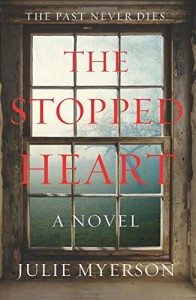 As a dedicated book
As a dedicated book maniac reviewer, I try and keep up with the cutting edge UK literary press. I’ve been intrigued by an emerging genre which I’ll call the ‘creepy yet quaint British village ghost story*’.
The Stopped Heart has been touted as such — a haunted house story set in the English countryside, with edge-of-your-seat suspense. Given its many stellar reviews and an enticing cover –I leapt in.
I know it’s been overdone, but The Stopped Heart is, at first, boringly set in two time periods, and (yawn) has two narratives – one in the present with Mary and Graham Coles – and the other, over 150 years ago with the farm family who once lived in the Cole’s cottage.
Delving further into what seems to be a predictable haunted tale, it’s not only the Coles’ cottage which is haunted — so are Mary and Graham. They have escaped to this countryside retreat to recover from a tragic loss. In the same cottage, 150 years in the past, Eliza narrates her large family’s hardscrabble farm story. Her sister, Lottie, strangely speaks of the present day family as if she knows them — and even names her kitten “Merricoles”, a version of the name “Mary Coles”. Ghosts, spirits, a haunted cottage — so far – so good, right? Get me another cup of tea and I’ll keep reading.
Except it all starts to go very, very wrong when the mysterious red-haired James Dix enters the circle of Eliza’s family. Thus begins the disturbing spiral involving both time periods and parallel stories of betrayal, underage lust and ultimately, grisly violence. And like an ill-advised roller coaster ride, you know, with dread, whats coming — but there is nothing you can do to get off. You’re strapped into the ride and you just gotta hang on and keep reading.
Ms. Myerson gives no indication when her narrative switches from one time period to another. I realized midway through the novel, that the author does this deliberately to enhance the fluidity of her past and present story-lines. The Coles’ modern-day cottage still harbors the violence of the past and Eliza and Lottie can sense the tragedy in the future. This can get confusing if you’re not paying attention. But, pay attention you will, because while creepy and often violent — The Stopped Heart is a compelling page turner. (Fair warning to any parents of young children out there, this book contains violence with young children as the victims.)
The modern day Coles struggle with their broken relationship, a surly teenage step-daughter and a sad flirtation with a neighbor. In the past, Eliza discovers her own budding sexuality, while simultaneously demanding her own (often funny and spunky) feminist beliefs. Meanwhile, the mysterious red-headed man disrupts everyone in both time periods. Some of the most intriguing writing involves Mary Coles “seeing” her kitchen and garden morph into the past. The smells, the dirt, the old furnishings all come alive through her eyes.
At the end of this gripping read, Ms. Myerson purposefully leaves many things unanswered – you won’t arrive a pat ending – creepily, you’ll continue to dwell on the events long after you’ve closed the book.
The Stopped Heart lead me to the edge of horror fiction, another blogger aptly labeled it “horror light”. I resolutely avoid horror fiction, I’m still recovering from my one (and only) Stephen King novel many years ago.
So why did I keep on reading well out of the limits of my comfort zone?
I kept turning the pages because of the writing. This is an intensely dark reading experience interspersed with beautifully captured characters coping with loss and unspeakable tragedies — the suffering of a stopped heart.
I recommend The Stopped Heart with caution and warnings (see above) and it had everything stacked against it for me (i.e., horror light). Yet, I had to keep reading and never once looked back. Which says a great deal about the appeal of this book – a scary roller coaster ride — you want to get off — but you can’t stop enjoying the thrill.
*Others in the same genre include Susan Hill, The Woman in Black and Sarah Waters, The Little Stranger…both on my TBR list — maybe, once I recover.


